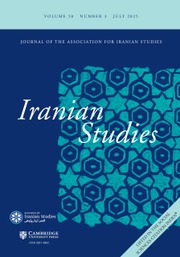The articles in this issue of Iranian Studies underscore the significance of revisiting history, be it ancient or contemporary, in light of new discoveries or neglected sources and artifacts.
In his article, Iraj Rezaei draws on archaeology and historical geography to painstakingly reconstruct the ancient routes leading from Upper Media, present-day Kangavar-Asadabad plain, to the metropolis of Ecbatana, modern-day Hamadan. Yousef Moradi and Almut Hintze examine four bullae from among 824 discovered through excavations at the world heritage site of Takht-e Solayman in West Azerbaijan province, which appear to represent Aphrodite and Eros. The authors explore their possible provenance and symbolic signification. Eugenio Garosi’s examination of texts from the early Islamic archives in Central Asia uncovers evidence of biliterate Arabic-Sogdian scribes in the mid-eighth century, challenging the assumption that Pahlavi acted as the intermediary between Arabic and Iranian scribal milieu.
Shiraz Hajiani’s study of the treatise Ḥikāyat-i Sayyid Nāṣir-i Khusraw offers invaluable insights into a subaltern group persecuted by the Nizari Ismaili hierarchy and silenced over time. Drawing on a document at the Bodleian, Cécile Bonmariage situates Dāʾūd al-Qayṣarī’s life and oeuvre in the Ilkhanid Tabriz intellectual scene rather than, as has been previously suggested, the emerging Ottoman realm. Habib Borjian’s study of the Tajik adaptations of the Turkic epic folktale of Köroğlu, known as Gurughli, provides an important overview of the scholarship on their origin and development and is accompanied by five sample texts.
In her article, Golnar Nikpour reminds us how material culture created during the hostage crisis shaped and was shaped by the US antagonism toward Iran. The ephemera she examines attest to sentiments that continue to resonate today. Finally, Morteza Abedinifard explores the question of modernity in Persian musical tradition through the compositions of two well-known composers. He illustrates how musical modernity in Iran has evolved along a path that diverges from European musical modernity.
The wealth of research encompassed in this issue speaks to the dynamism and vibrancy of the multitude of disciplinary and interdisciplinary perspectives that make up our scholarly community.



